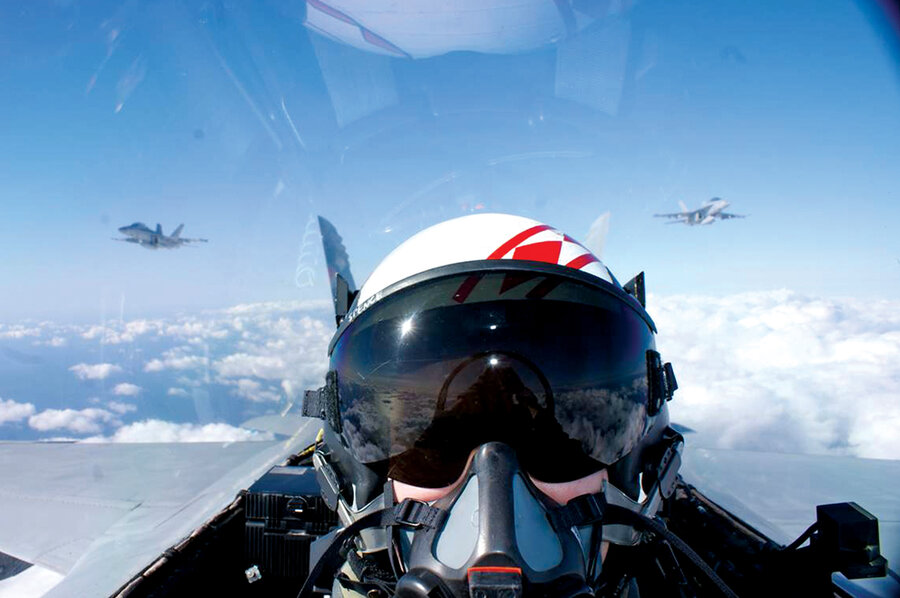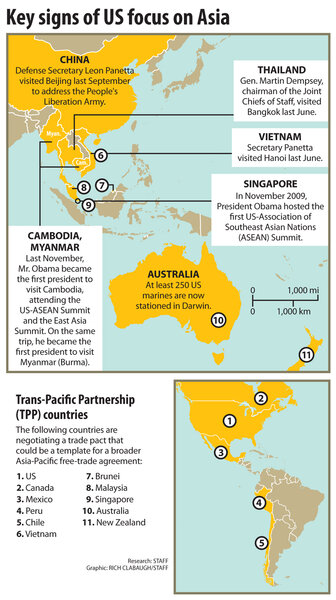How US military plans to carry out Obama's 'pivot to Asia'
Loading...
| Washington
The Pentagon's No. 2 official, Ashton Carter, picked a telling time to discuss the US military's plans for its new strategic focus on the Asia-Pacific.
At Europe's premier security conference in Munich, Germany, this month, Mr. Carter took the opportunity to reassure concerned NATO allies, among others, that America's focus on Asia would not mean its abandonment of Europe. Some US partners have been concerned that even the phrase "pivot to Asia" implies that the United States would be turning its back on Europe.
"Asia has no NATO, has not had a NATO, has had no way of knitting together countries and healing the wounds of the Second World War," he said, making the case for the shift. "Europe is a source of security and not a consumer of security in today's world, fortunately," Carter said. While Asia has prospered for 70 years, "it's not automatic," he added. "And I think a central reason for that peace and prosperity has been the pivotal role of American military power in that part of the world."
It's a role that is slated to grow in the near term (even if John Kerry raised some questions during his Senate hearing to become secretary of State). Indeed, the US military is aiming both to strengthen relationships with rising economic partners in the region and to increasingly act as a counter to rivals for power – most notably, China.
As outgoing Defense Secretary Leon Panetta has said, the Pentagon's strategic shift is being driven by a recognition that America's security in the 21st century "will be linked to the security and prosperity of Asia more than any other region on earth."
The shift has implications for the services, too, particularly as America's decade-long wars in Iraq and Afghanistan come to an end. The Army and Marine Corps have been the go-to branches during this time. Now it is the Navy to which the Pentagon will be increasingly turning.
Currently, half of the Navy's ships are stationed in the Asia-Pacific region. This helps the US build relationships in the region, as well as reassure allies, says Adm. Jonathan Greenert, chief of naval operations.
Even as the threat of defense cuts loomed, resulting in calls to decrease the size of the Navy's aircraft-carrier fleet from 11 to 10, Secretary Panetta pushed back, citing the need for a Navy "able to penetrate enemy defenses."
The Pentagon is also putting money into developing a new "afloat forward staging base" in the Pacific, which can be used for everything from counter-piracy to mine clearing to Special Operations Forces missions.
Perhaps most public is the move of 250 US Marines to Darwin, Australia, last April, with the promise of as many as 2,500 at any given time in the years to come. Also, some 85,000 US troops are currently stationed in South Korea and Japan.
President Obama called the new troop deployment to Australia "necessary to maintain the security architecture of the region." Further, he added, "This will allow us to be able to respond in a more timely fashion" and "to meet the demands of a lot of partners in the region."
These partners include rising economic powers in Southeast Asia such as Thailand, which has an "extraordinarily key location" given its borders with Myanmar (Burma), Malaysia, and Vietnam, according to Gen. Martin Dempsey, chairman of the Joint Chiefs of Staff. "They're a very credible, welcoming military power," he said in a visit there last June.
The US military's moves are also considered a counter to other rivals for power in the region. Russia's actions in the Pacific bear watching, noted the outgoing head of the US Pacific Command last year. The country's "increased naval and strategic air force operations, cyberspace activities, and arms sales throughout the Asia-Pacific are signaling Russia's emphasis" on the region, said Adm. Robert Willard.
Then there is the threat of North Korea, although most military analysts say the US pivot toward the Pacific has little to do with that regime. "North Korea is in many ways its own cancer that requires its own treatment," says Ely Ratner, a fellow at the Center for a New American Security in Washington.
It is clear, however, that the Pentagon has one rising power firmly in mind as it launches its strategic shift: China. Senior military officials have long expressed concern about China's interest in developing unmanned air systems, as well as its growing capabilities in nuclear weapons, missile defense, and advanced submarines.
Defense analysts have noted that the Australia deployment had been planned for some time, but Mr. Obama used an announcement about it as an opportunity to send China a message.
"It was a DOD [Department of Defense] thing, but the White House grabbed it and announced it," says Michael Green, senior vice president for Asia at the Center for Strategic and International Studies in Washington. Obama's announcement also had the effect of giving the administration's Asia-Pacific pivot "a military hue," he says.
Explicitly citing China in conjunction with security concerns and the Asia-Pacific pivot raises its own quandaries, Dr. Ratner says.
"Perhaps the biggest question is, how do we reconcile the fact that we're deepening security relationships with other partners in the region with the equally important goal of maintaining a stable relationship with China?" he warns. "As we strengthen these ties with other countries, China is going to become increasingly insecure."
It is a problem to be managed, rather than solved, he adds.
"The last thing you want to have is miscalculation between large militaries," Adm. Samuel Locklear III noted as he took over US Pacific Command last year. China is an "emerging power, and we are a mature power," he added. "How they emerge, and how we encourage them, will be an important key to both China and the United States."
The US approach has included some efforts to reassure China. Panetta addressed more than 300 members of the People's Liberation Army during a visit there last September, telling them, "It will be your responsibility to help carry the US-China relationship forward."
He acknowledged, too, a "lack of strategic trust" that often leads to suspicion between the two countries.
Yet as the pivot goes ahead, the overarching aim for the US military must include not being caught off guard by Chinese military advances, David Helvey, acting deputy assistant secretary of Defense for East Asia, warned last May.
"We have seen in the past instances where China has developed weapons systems that have appeared earlier than we expected," he said. "We've been surprised in the past.






